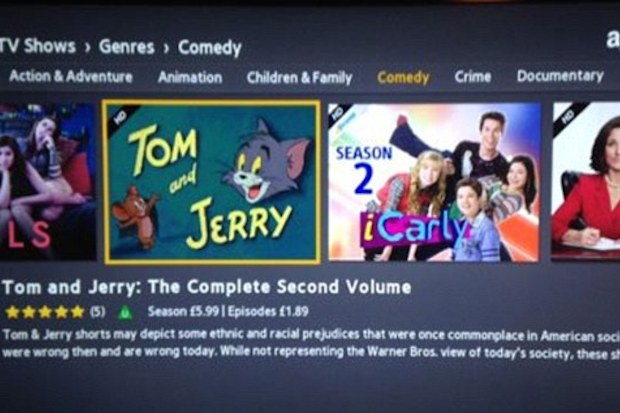I can’t wait to watch Tom and Jerry, The Complete Second Volume, on Amazon Prime, to which, as luck would have it, I belong. Obviously I’ve seen the cartoons before – I got them in years ago for my children when they were at an age at which everyone else was looking the hellish ‘In the Night Garden’ – but this time it’ll be for the subversive thrill of the warning:
‘Tom and Jerry shorts may depict some ethnic and racial prejudices that were once commonplace in American society. Such depictions were wrong then and are wrong today.’
It reminds me of the sense of subversiveness I got when I bought Tintin in the Congo for my son, after he’d read all the other books. It was wrapped up in such a way that you couldn’t possibly browse the contents and there was a big red warning sticker inside. It was along the same lines: attitudes very much of their day, unsuitable for ours, etc. Actually, some of the content was pretty hair-raising – the last big picture, I recall, showed the black natives venerating totems – and I did feel the need to point out to the reader that Africans weren’t really like that now.
But T&J are another matter. The gist of the objections is that the cartoons show a black housekeeper/maid in a subordinate role in the kitchen – think Big Mammy in Gone With the Wind. Except I don’t remember seeing her entire person. Since the shots were from the perspective of a cat and a mouse what you actually saw were the black legs and an overall impression of stoutness. Her best line was, I recall: ‘Now get out and STAY OUT’, as she booted Tom into the cold – a line my daughter adopted with visitors.
So, what exactly is wrong with this? Is it the suggestion that black women were employed in a servant capacity in white households – and we’re going back to the Forties and Fifties here? Well, they were. Obviously. In fact the more remarkable aspect of the early T&J cartoons isn’t the supposed racism – it’s that Tom was back then a really scary character, one who wasn’t always going to be bested by a mouse, but a cat who really might eat him. There’s one shot of Tom’s mouth as a huge gaping tunnel that you wouldn’t get away with now.
Which isn’t to say that cartoons weren’t racist back then. The most obvious instance of grotesque racial prejudice I came across in my cartoon viewing was, in fact, nothing to do with black people. It was a very early Disney sequel, circa 1933, to the rather brilliant and very funny cartoon about the Three Little Pigs, except in this case, it was the Three Little Wolves. And, you know, those little wolves and their horrible dad were caricature Germans – accent, demeanour, diet, the lot.
It took about half a minute to discern a dig at the Nazis and, given the Jewish presence in the Hollywood of the era, that was hardly surprising. But, out of context, it is undeniably racist stereotyping, miles more offensive than the Big Mammy figure in Tom and Jerry. Will it get a health warning? I doubt it, myself.
Anyway if a contemporary version of Tom and Jerry – and they’re on a loop on some cartoon networks – were unwise enough to feature someone in a servant capacity in a cartoon, the correct thing to do would be to give the lady tawny legs and an Hispanic accent. It would at least have the merit of being true to modern American life.







Comments